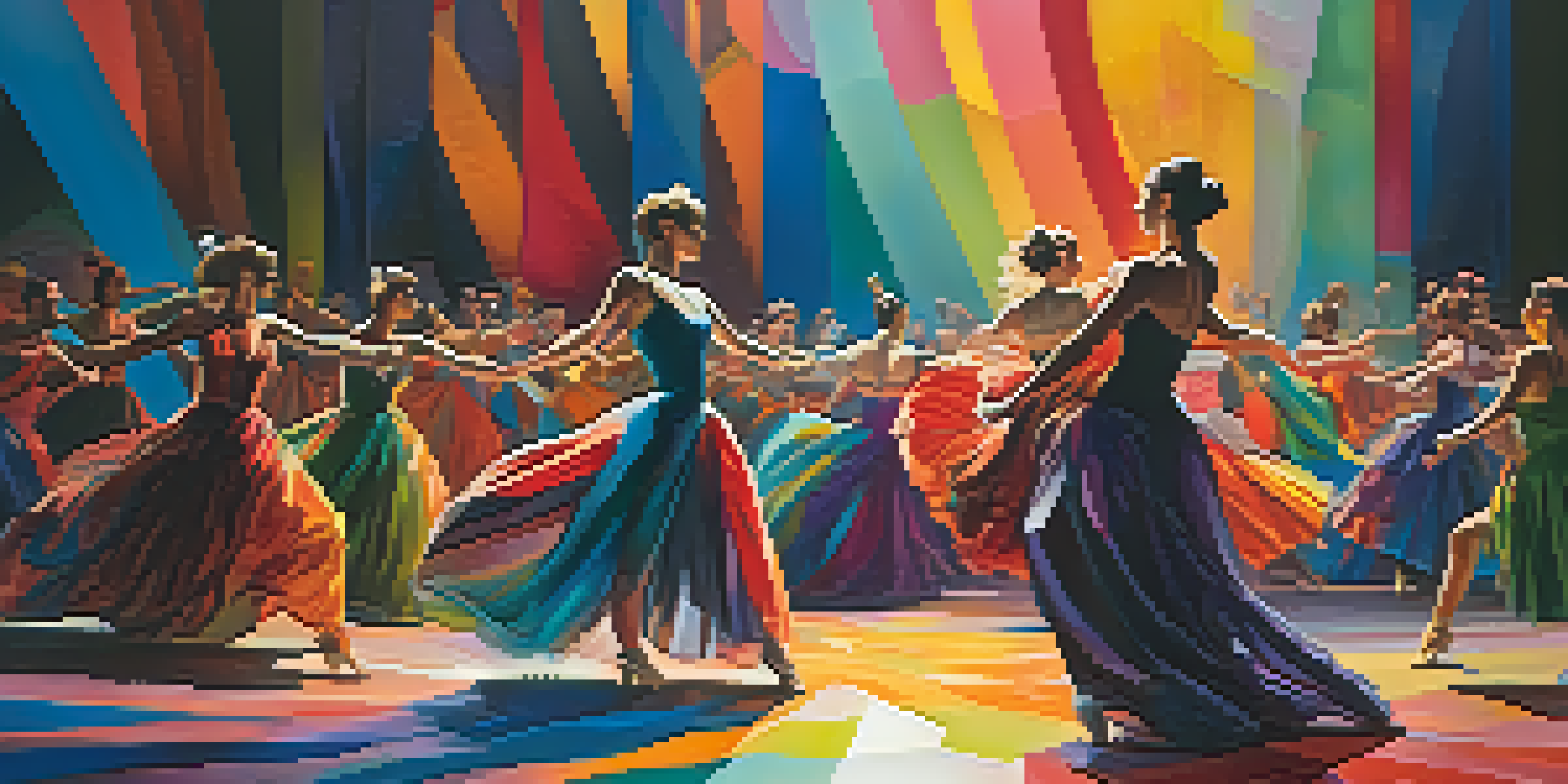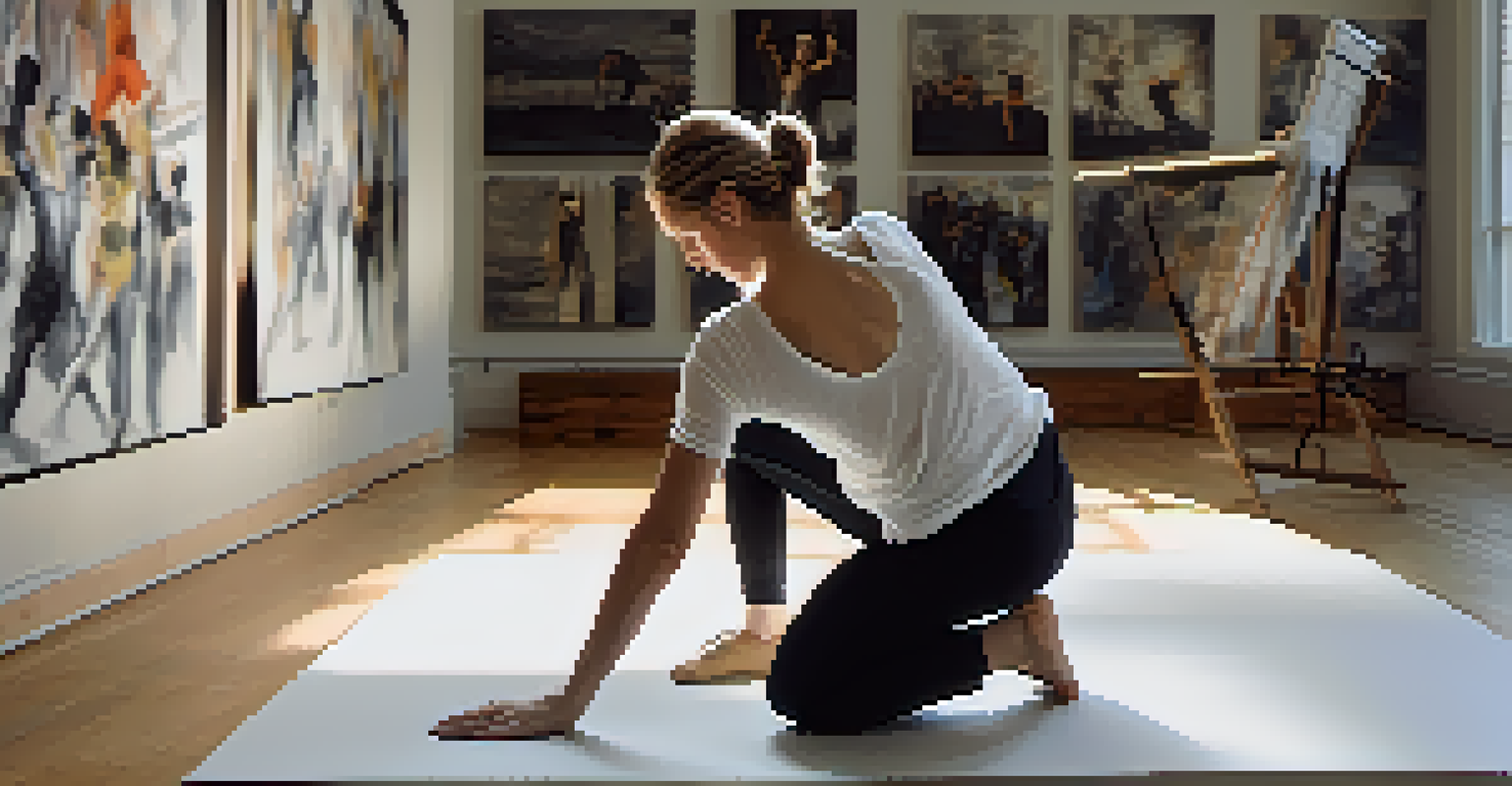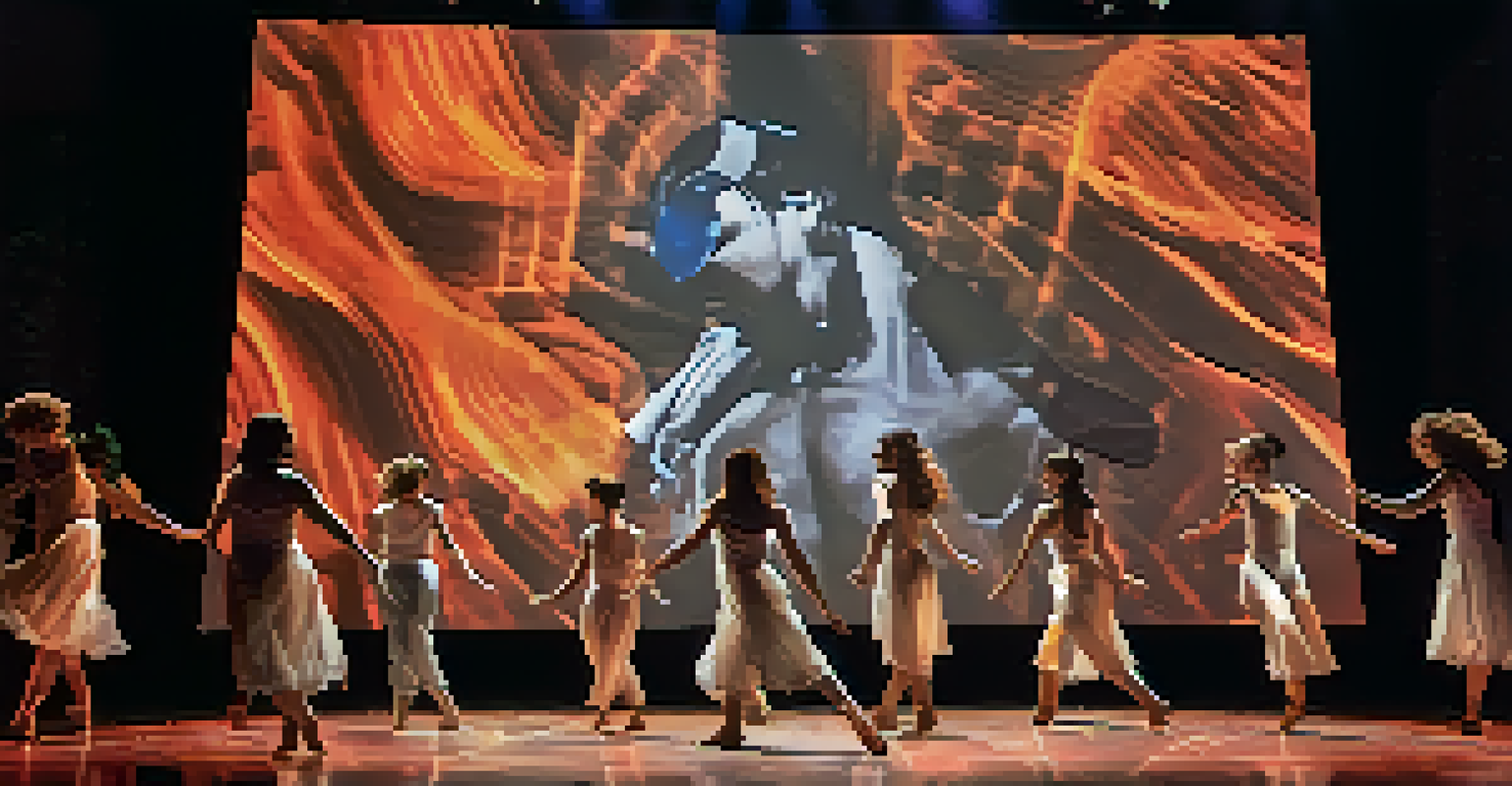The Intersection of Dance and Visual Art in Modern Theater

The Role of Dance in Storytelling Through Theater
Dance has long been a powerful tool for storytelling, offering a visceral way to express emotions and narratives. In modern theater, choreographers blend movement with dialogue and visuals to create a richer experience for the audience. The body becomes a medium through which stories unfold, often conveying what words cannot.
Dance is the hidden language of the soul.
For instance, in productions like 'The Lion King,' dance sequences are not just entertainment; they are integral to character development and plot progression. Each movement helps to reveal the inner thoughts and struggles of the characters, making the story more relatable. This fusion of dance and narrative enhances the emotional impact, resonating deeply with viewers.
Moreover, dance can also reflect cultural contexts, adding layers of meaning to the performance. By incorporating traditional dance styles, modern theater can celebrate and preserve cultural heritages, fostering a sense of connection among diverse audiences. Thus, dance in theater is not only expressive but also deeply rooted in societal narratives.
Visual Art's Influence on Theater Aesthetics
Visual art plays a critical role in shaping the aesthetic experience of theater. Set designs, lighting, and costumes are all influenced by various artistic movements, creating a visual feast that complements the performance. This synergy between visual art and theater invites audiences to immerse themselves in a meticulously crafted world.

For example, productions like 'Sleep No More' utilize striking visual elements to create an atmospheric experience. The innovative use of spaces and visual storytelling transforms the theater environment, making the audience feel like active participants. This approach highlights how visual art can enhance narrative depth and viewer engagement.
Dance Enhances Storytelling Depth
In modern theater, dance serves as a powerful narrative tool, expressing emotions and character development beyond words.
Moreover, the collaboration between visual artists and theater makers often results in groundbreaking designs that challenge traditional forms. By pushing the boundaries of what theater can be, these partnerships invite audiences to reconsider their perceptions of art and performance. This evolving relationship continues to shape the future of modern theater.
The Interplay Between Movement and Visual Imagery
The intersection of dance and visual art creates a unique dialogue that enriches the theatrical experience. When dancers move against a backdrop of vivid visuals, the result is a dynamic interplay that captivates the audience. This relationship allows for a multi-sensory experience where sight and movement enhance one another.
Art is not a thing; it is a way.
Take, for instance, the performances of choreographer Akram Khan, where intricate dance movements are often set against stunning visual projections. This blend transforms the stage into a canvas, making each performance a living piece of art. The visuals not only serve as a setting but also as an integral part of the storytelling.
Furthermore, this interplay often encourages audiences to engage with the performance on multiple levels. Viewers are invited to interpret the dance and visuals in their own unique ways, fostering personal connections with the material. This engagement highlights the power of combining art forms in modern theater.
Choreography as a Form of Visual Art
Choreography itself can be viewed as a form of visual art, where the body becomes a brush painting on the canvas of the stage. Just as a painter composes a piece with color and form, a choreographer arranges movement and space to create visual beauty. This artistic expression transcends mere performance; it becomes a visual narrative in motion.
In productions like 'Pina' by Wim Wenders, the choreography is not only about the dance but also about how bodies interact within a visual space. The deliberate placement of dancers creates striking images that linger in the viewer's mind long after the show is over. Here, choreography is elevated to an art form that speaks volumes through movement.
Visual Art Shapes Theater Aesthetics
The integration of visual art in theater, such as innovative set designs and lighting, creates an immersive experience that complements performances.
Additionally, choreographers often draw inspiration from visual art to inform their movement choices. The incorporation of textures, shapes, and colors from visual art can influence how a dance is performed, creating a cohesive aesthetic experience. This relationship emphasizes the seamless blend of dance and visual art in modern theater.
Innovative Collaborations in Modern Productions
The collaboration between dancers, visual artists, and theater directors has led to innovative and engaging productions that break traditional boundaries. These partnerships allow for creative experimentation, resulting in fresh interpretations of classic narratives. By merging different art forms, artists can explore new dimensions of storytelling.
One remarkable example is the collaboration between the dance company Crystal Pite and visual artist Jonathon Young in 'Betroffenheit.' This production weaves together movement, projection, and narrative to explore themes of loss and trauma. The combined talents create a powerful emotional experience that resonates with audiences.
Moreover, these innovative collaborations often challenge audiences to rethink their definitions of theater and art. As artists push the envelope, viewers are encouraged to embrace the unexpected and appreciate the richness of blended artistic expressions. This evolution is vital for the continued relevance of modern theater.
The Impact of Technology on Dance and Visual Art
Technology has revolutionized the way dance and visual art interact in modern theater. With advancements in digital media, artists can incorporate multimedia elements that enhance the storytelling process. From projections to interactive installations, technology opens new avenues for creativity and expression.
For instance, in performances that utilize augmented reality, audiences can experience a fusion of live dance and digital visuals in real-time. This innovative approach not only captivates the audience but also deepens their emotional connection to the performance. Technology thus acts as a bridge, linking traditional art forms with contemporary practices.
Collaboration Fuels Artistic Innovation
Innovative collaborations between dancers, visual artists, and directors are pushing the boundaries of traditional storytelling in modern theater.
However, the integration of technology also raises questions about authenticity and the nature of live performance. As artists navigate this digital landscape, they must find a balance between innovation and preserving the essence of theater. This ongoing dialogue will shape the future of dance and visual art in modern theater.
Celebrating Diversity Through Dance and Visual Art
Dance and visual art in modern theater serve as powerful mediums for celebrating diversity and inclusivity. By showcasing a variety of cultural expressions, productions can highlight the richness of human experience. This celebration fosters understanding and appreciation among diverse audiences.
For example, performances that incorporate traditional dance forms from various cultures not only educate but also empower marginalized voices. Productions like 'Alvin Ailey American Dance Theater' exemplify how dance can be a platform for cultural storytelling and representation. Such initiatives encourage audiences to embrace diversity in all its forms.

Moreover, the collaboration between artists from different backgrounds can lead to innovative and meaningful work that resonates with contemporary issues. By weaving together diverse narratives, modern theater can address social themes and inspire dialogue among audiences. This commitment to inclusivity is essential for the evolution of the art form.
The Future of Dance and Visual Art in Theater
As modern theater continues to evolve, the intersection of dance and visual art promises to remain a vibrant area of exploration. Artists are constantly pushing the boundaries of creativity, experimenting with new forms and techniques. This ongoing innovation keeps the theatrical landscape fresh and engaging for audiences.
Looking ahead, the integration of technology and diverse artistic practices will likely shape the future of dance and visual art in theater. As artists embrace new tools and mediums, the potential for groundbreaking collaborations is limitless. This evolution will continue to redefine what theater can be.
Ultimately, the future of modern theater lies in its ability to adapt and respond to the changing world. By celebrating the intersection of dance and visual art, theater can remain a powerful platform for storytelling, connection, and cultural exchange. The possibilities are as limitless as the imagination itself.